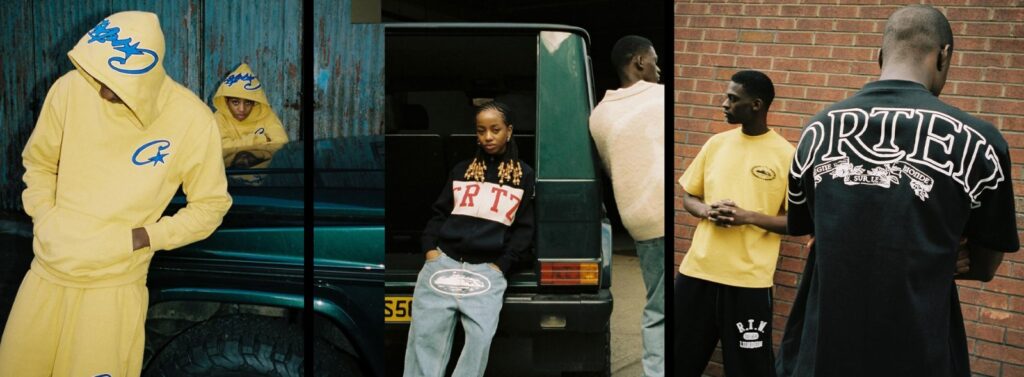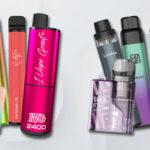Kapital and Corteiz come from two different corners of the fashion world. Kapital was founded in Japan by Toshikiyo Hirata in the mid-1980s, originally focusing on denim. Over time, it evolved into a global symbol of Japanese craftsmanship, incorporating Americana and traditional textiles into its design. Corteiz, launched in 2017 by Clint419 in London, started as an underground movement. It quickly gained traction with its anti-establishment tone, secret drops, and powerful slogans. While Kapital represents legacy and evolution, Corteiz is a product of disruption and modern youth culture — both powerful, but for different reasons.
Visual Style and Creative Expression
Kapital’s design philosophy embraces imperfection, layered textures, and a handcrafted aesthetic. It often draws from vintage styles, Japanese symbols, and folk art, resulting in eclectic, statement-making pieces. Its clothing feels like wearable storytelling. Corteiz operates in a sharper, more stripped-back style. Its visual identity is rooted in bold typography, clean cuts, and tactical influences — especially visible in its iconic cargos and military-inspired outerwear. Corteiz designs speak through attitude and exclusivity. Where Kapital celebrates chaos in harmony, Corteiz is precise and powerful. Both offer creativity, but their visual tones speak to different fashion energies.
Product Approach and Release Strategy
Kapital offers full seasonal collections, with dozens of products ranging from patchwork jeans to kimono-style jackets and accessories. Its output is high-volume but detailed, perfect for collectors and fans of variety. Corteiz functions almost like a secret society, dropping small collections unexpectedly and never restocking. It uses limited supply and secrecy to build hype. Where Kapital’s appeal lies in uniqueness and volume, Corteiz wins with restraint and anticipation. This reflects two philosophies: Kapital invites you to explore and indulge, while Corteiz rewards those who act fast and stay in the loop.
Marketing Tactics and Brand Buzz
Kapital doesn’t rely on flashy campaigns or influencer deals. Its fame grew organically, mostly through fashion insiders, stylists, and those who appreciate design quality. Corteiz, on the other hand, has mastered guerrilla marketing. From blocking London streets with crowds during pop-ups to locking its site behind codes, Corteiz knows how to create noise. Its brand buzz is designed to feel exclusive and rebellious. Kapital earns respect through subtlety; Corteiz earns attention through spectacle. Both brands understand the power of identity, but one builds it slowly, while the other strikes fast.
Target Markets and Consumer Mindsets
Kapital’s audience is usually older or more style-experienced — those who care about craftsmanship, cultural depth, and standout design. Its customers often wear Kapital to make a personal or artistic statement. Corteiz’s base is younger — students, creatives, and street culture enthusiasts who value being early adopters. Wearing Corteiz feels like being part of a tribe that “gets it.” It’s a badge of cultural awareness. Kapital is for those who seek meaning in detail. Corteiz is for those who want their clothing to say something loud, clear, and immediate.
Cultural Presence and Star Power
Kapital’s influence can be seen across high fashion editorials and celebrity closets. Pharrell, Ye (Kanye West), and A$AP Rocky have all been spotted wearing Kapital’s patchwork denim and iconic pieces. It’s a go-to brand for stylists looking to push creative boundaries. Corteiz has built its name from the ground up, especially through UK rap scenes, athletes, and Gen Z tastemakers. Footballers like Jude Bellingham and artists like Central Cee have helped fuel its popularity. Kapital’s status comes from design; Corteiz’s comes from culture. Both dominate, just in very different circles.
Price Range and Scarcity
Kapital’s prices reflect its artisanal production. Most pieces are handmade in Japan, using traditional dyeing and sewing techniques. Jackets and jeans can range from $400 to over $1000. Corteiz offers more affordable pricing at retail, but due to limited availability and no restocks, resale prices can sometimes double or triple. The real cost of Corteiz is in accessing it. Kapital is expensive due to craftsmanship; Corteiz becomes expensive due to demand and exclusivity. In the end, both carry a premium — one for quality, one for hype.
Sustainability and Brand Ethics
Kapital’s commitment to slow production and local sourcing gives it a natural edge in sustainability. Many pieces are made using recycled materials, traditional methods, and hand-finishing. The brand doesn’t chase trends — it builds lasting garments. Corteiz hasn’t positioned itself as a sustainable label yet, but its limited runs reduce waste by default. There’s little overproduction, and its loyal fanbase ensures most items are worn and valued. While Corteiz still has room to grow in this area, its exclusivity helps reduce fashion landfill. Kapital leads in ethics; Corteiz shows potential in responsible hype.
Community Loyalty and Brand Impact
Kapital has a strong niche following that spans across continents. Fans often form deep emotional connections with their garments, treating them as wearable art. It’s not uncommon to see Kapital collectors break down the history behind their jackets or denim. Corteiz fosters a completely different kind of loyalty — one based on urgency, code-sharing, and cultural clout. Its community is active, loud, and highly engaged online. Corteiz drops often feel like events, not just product launches. Both brands build fierce loyalty — Kapital through appreciation, Corteiz through inclusion in something exclusive.
Final Comparison: Two Icons, Two Paths
Kapital and Corteiz are proof that streetwear is not one-size-fits-all. Kapital reflects history, heritage, and artistic complexity. It’s for the thinker, the collector, the stylist. Corteiz represents speed, rebellion, and cultural tension. It’s for the leader, the insider, the disruptor. One celebrates detail and tradition; the other builds hype through mystery and minimalism. Whether you connect more with Kapital’s quiet brilliance or Corteiz’s loud movement, both brands stand at the top of modern fashion — not just for what they sell, but for what they represent.


